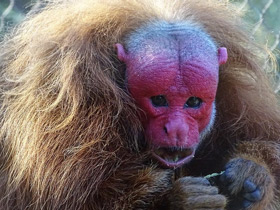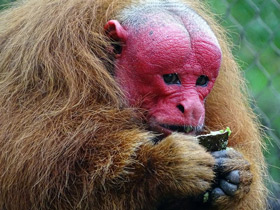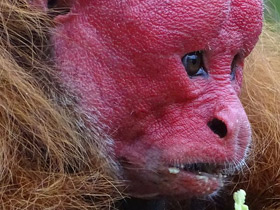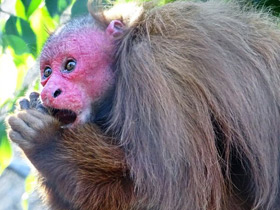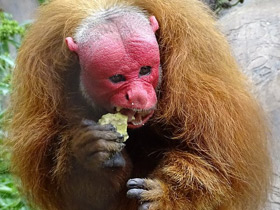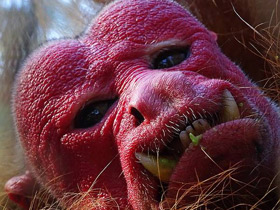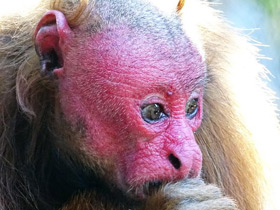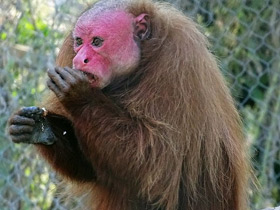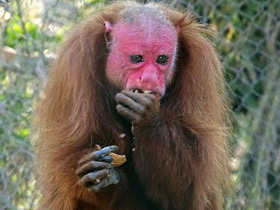The bald uakari (Cacajao calvus) or bald-headed uakari
 The bald caiman (Cacajao calvus) is included in the IUCN Red List as a "vulnerable species"
The bald caiman (Cacajao calvus) is included in the IUCN Red List as a "vulnerable species"
The bald uakari (Cacajao calvus) or bald-headed uakari is a small New World monkey characterized by a very short tail; bright, crimson face; a bald head; and long coat. The bald uakari is restricted to várzea forests and other wooded habitats near water in the western Amazon of Brazil and Peru.
Taxonomy
There are four recognized subspecies of the bald uakari, each of which is considered vulnerable to extinction:
- White bald-headed uakari, Cacajao calvus calvus;
- Ucayali bald-headed uakari, Cacajao calvus ucayalii;
- Red bald-headed uakari, Cacajao calvus rubicundus;
- Novae's bald-headed uakari, Cacajao calvus novaesi.
Appearance
Cacajao calvus is a species of platyrrhine primate of the family Pitheciidae. This primate has an unusual appearance and cannot be confused with any other primate. The most notable feature of its appearance is its broad, flat, hairless face, coloured bright red, which gives the Cacajao calvus an eerie appearance.
The Cacajao calvus is the largest member of the Pitheciidae family, reaching a length of 54 to 57 cm and a weight of 2.9 to 3.5 kg. The tail of the Cacajao calvus is short, 14 to 19 cm in length (about one third of the body length); they are the only short-tailed monkeys in South America. Although the face, cheeks and top of the head are almost bare, they still grow sparse, silky hairs; longer, beard-like hairs may grow on the throat. The hair is long and shaggy and varies in colour from pale grey or yellowish to reddish-brown, depending on the subspecies.
Three types of colouring are clearly distinguishable:
- In the subspecies Cacajao calvus calvus the coat colour is almost white, the face red.
- Cacajao calvus rubicundus is light red in the range of brown to chestnut, the hands, feet and ears are brown, and the face and forehead are bright red.
- Monkeys of this genus have large, human-like ears and wide-spaced nostrils. They have fine, protruding incisors, adapted for specialised feeding. The fangs of Cacajao calvus are enlarged and the chewing teeth are rather small.
Habitat
The Cacajao calvus is common in South America in the northwestern part of the Amazon lowlands. Its habitat includes the rainforests of western Brazil, southern Colombia and eastern Peru. These primates are less common than many other American monkeys, preferring habitats of a certain type and settling mainly on the banks of small forested rivers (avoiding large rivers), but the Cacajao calvus also likes flooded forests. Cacajao calvus spend most of their time in the canopy of large trees and rarely descend to the ground, at least during the rainy season when the undergrowth is flooded. They are active during the day and move mainly on four limbs, but sometimes jump a considerable distance. When feeding, the Cacajao calvus usually hovers only on its hind legs. During dry periods, these monkeys occasionally descend to the ground.
Social behaviour
These primates usually live in large groups of 10 to 50 and sometimes up to 100 individuals. These groups consist of several males and females, as well as common offspring. Occasionally aggression occurs between individual members of the group. In their daily search for food, large groups often break up into smaller subgroups and reconvene at night. Cacajao calvus communicate by a series of sounds that allow the subgroups to keep in contact with each other. Mutual grooming also plays an important role in social life.
Nutrition
The diet of the Cacajao calvus consists mainly of hard-shelled fruits and unripe seeds. They also eat flowers, leaves and insects in small quantities. During the rainy season, Cacajao calvus forage in the upper layers of trees; during dry periods they usually collect fallen fruits and seeds on the ground.
Reproduction
Interestingly, the red hairless face is an indicator of the health of the Cacajao calvus. The faces of sick animals turn pale pink, which immediately reduces their success as mates. Births usually occur during the dry period from October to November, but can also occur during other seasons.
After about six months of gestation, the female usually gives birth to one calf each. Initially it is grey in colour and has facial hair. At three to five months, the calf begins to eat solid food, but the mother does not stop feeding it with milk until its second year. In the third year, the head loses its hair and females reach sexual maturity at the end of this year.
In the male, this process continues - at least in captivity - for about six years.
In captivity, the Cacajao calvus has survived up to 30 years; its lifespan in the wild is unknown.
Threats to existence
The main threats to the Cacajao calvus are human destruction of its rainforest habitat. These primates are much more sensitive to human interference than other South American monkeys. Their tree-dwelling habitat near the river facilitates hunting from boats. Some indigenous tribes do not hunt Cacajao calvus because of their humanoid appearance, but in other regions, such as Peru, they are hunted extensively for their meat and to sell their heads to tourists. Sometimes the young are captured and kept as pets, often accompanied by the killing of the mother. The Cacajao calvus is included in the IUCN Red List as a vulnerable species.

















